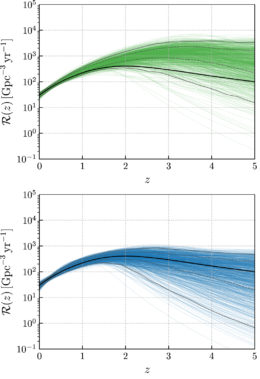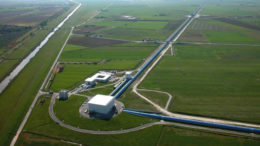To know the rate of binary black hole mergers over the lifetime of the universe is to know more about the universe’s evolution. For instance, how were binary black holes first created? Did ancient stars in the early universe play a role? And where does chemical composition come into the picture?
But before all that, we first need to answer this question: how do you even determine the history of binary black hole mergers?
Have Data, Do Science!
Discoveries like the one announced this week illustrate how gravitational-wave observatories like the Laser Interferometer Gravitational-wave Observatory (LIGO) and the Virgo interferometer have pushed the study of binary black hole (BBH) mergers from theory into observation. However, we still haven’t entered an era where BBH mergers are commonplace. This means that it’s hard to do studies that need large ensembles of mergers to make definitive conclusions — like measuring how the rate of BBH mergers changes over the lifetime of the universe.Another problem is that gravitational-wave observatories can only probe a relatively small volume of the universe. Models have suggested that historical rates of BBH mergers peak at a distance that’s outside the range of current observatories, so what’s to be done?

Two different example models of merger rates versus redshift. Here the peak merger redshift is seen around z ~ 2, and the growth of the low-redshift merger rate is described with a factor called α. [Callister et al 2020]
Redshifts and a Gravitational-wave Background
A lot, it turns out! In a new study, a group of researchers led by Tom Callister (Flatiron Institute) used LIGO/Virgo gravitational-wave data to put observational constraints on the evolving rate of BBH mergers. A special feature of their study was that they didn’t just consider directly observed mergers — they also looked at the overall background of gravitational-wave signals that observatories can detect.
To be specific, Callister and collaborators were attempting to measure how the rate of BBH mergers changes with redshift. LIGO/Virgo can detect individual mergers out to a redshift of z ≲ 1, but models suggest that BBH merger rates peak somewhere between z ~ 2 (about 10 billion years ago) and z ~ 4 (nearly 12 billion years ago). So, Callister and collaborators decided to combine information from individual BBH mergers (“shouts”) with the limits we have on the gravitational-wave background created by more distant, undistinguished mergers (“murmurs”).
In the Background No More

Predicted merger rate (in mergers per cubic gigaparsec per year) versus redshift based on ~1 year of simulated Advanced LIGO observations at design sensitivity. The solid line is the “true” merger rate used to generate the simulations; the other lines show the results from different mock detections. The top plot is based solely on directly observed mergers, while the bottom plot includes the gravitational-wave background in the analysis. Click to enlarge. [Callister et al 2020]
By combining direct merger detections with upper limits on the gravitational-wave background for the first time, Callister and collaborators were able to rule out certain combinations of peak merger redshifts and local merger growth rates. In particular, they reject combinations of zp ≳ 1.5 and α ≳ 7, limiting the merger rate to peak more recently than ~9 billion years ago if the local growth rate of BBH mergers is large.
So what’s next? With the upgraded Advanced LIGO and other gravitational-wave observatories coming online soon, many more mergers will be within reach. The limits the authors have already established are just a start; the authors also show that the upgraded Advanced LIGO may make it possible to pin down the peak merger redshift with certainty. So keep your eyes peeled!
Citation:
“Shouts and Murmurs: Combining Individual Gravitational-Wave Sources with the Stochastic Background to Measure the History of Binary Black Hole Mergers,” Tom Callister et al 2020 ApJL 896 L32. doi:10.3847/2041-8213/ab9743

